At the end of October 2021, the US market (S&P 500) is back at an all-time high of almost 4,500, which is more than 30% above the level before the Covid-19 pandemic hit in February 2020 (3,400). The European market (Euro Stoxx 600) is at a similar all-time high of around 4500, but has only seen a limited increase of around 8% from pre-COVID-19 levels (3800 in February 2020). But where are the markets heading?
As is often the case when trying to look into the future, there is no simple answer. My own view is basically that trying to predict where the markets will be in 6, 12 or 24 months is a waste of time. But if we can’t predict the future, we can at least try to figure out where we are today. To that end, we will look at three recognized indicators that can be used to assess the current price level of the market:
- The “Buffet indicator”
- Shiller CAPE ratio
- Tobin’s Q ratio
These indicators are not useful as short-term signals of where the market is heading. Periods of very high or low prices can last for many years. But the indicators can help us evaluate what we can reasonably expect in terms of returns over a long time horizon (5+ years).
1. The Buffet indicator - Wilshire to US GNP
One of the best indicators to understand how expensive (or cheap) the current market is, is the so-called ‘Market cap to Gross National Product (GNP)’. Or in Danish, the market’s market capitalization compared to gross domestic product (GDP). Back in 2001, Warren Buffett stated in an interview with Fortune Magazine that“it is probably the best single measure of where valuations stand at any given moment.”
Looking at the global stock market, there’s no getting around the fact that the US remains the biggest player and often sets the tone for the rest of the world. In fact, in 2021, the US accounts for just over half of the total value of listed companies in the world. If you own a global index or have a portfolio that roughly matches the distribution of the world market, the price of the US market is therefore very indicative of where we stand in terms of prices. the historical levels. Also for Danish investors.
The indicator is calculated by inserting the Wilshire 5000 into the numerator, which is an index of the 5000 largest companies in the US. In the denominator is the US Gross National Product (GNP), which is the total revenue of all US citizens (regardless of where they reside).
Current data
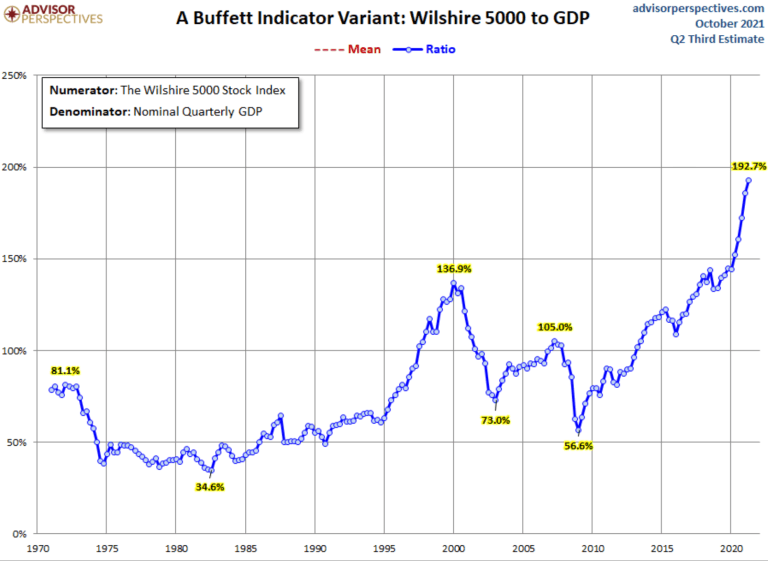
As the graph shows, at the end of October 20021 we are still at the highest level in the last 50 years. This is a slight increase from the level just six months ago, when we were at 170%. If we reflect on it for a moment, it’s not really that surprising. The market is at an all-time high and economies around the world – including the US – have seen quite significant drops in their gross domestic products due to Covid-19.
Some may legitimately argue“well, the market generally rises 6-8% per year, so the graph can’t possibly give a true picture over a longer period of time“. It’s a fair point, but even when correcting for the general increase in the market, we are today 102% above the 50-year average. That is, after adjusting for the general market rise. The US stock market is now higher than it was at the peak of the IT bubble in 1999, when we reached 96% above average.
2. Shiller CAPE Ratio
Professor Robert Shiller of Yale University invented the Shiller CAPE ratio to measure market valuation. The standard Price/Earnings (P/E) ratio measures price to earnings. Shiller PE eliminates the fluctuations in the ratio caused by companies’ operating margins over the course of a business cycle. Hence the name “Cyclical Adjusted Price Earnings” ratio, or CAPE.
Current data
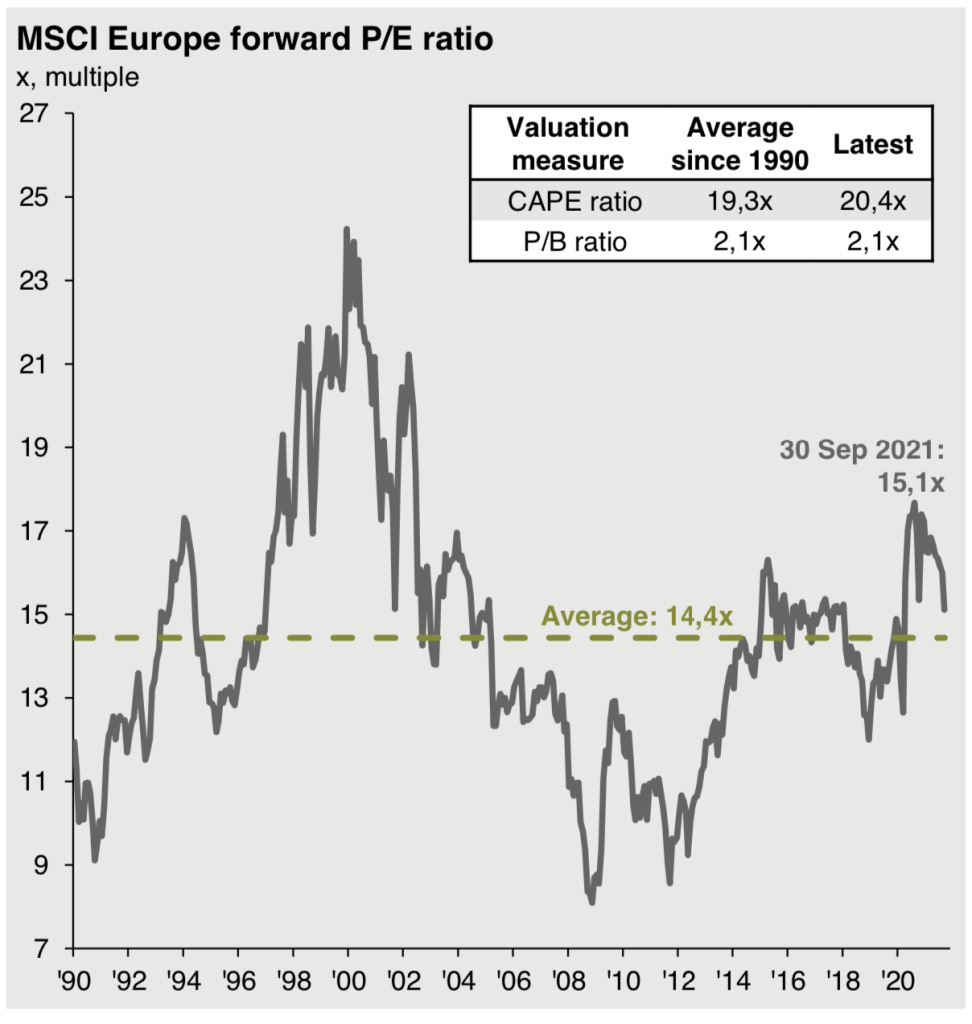
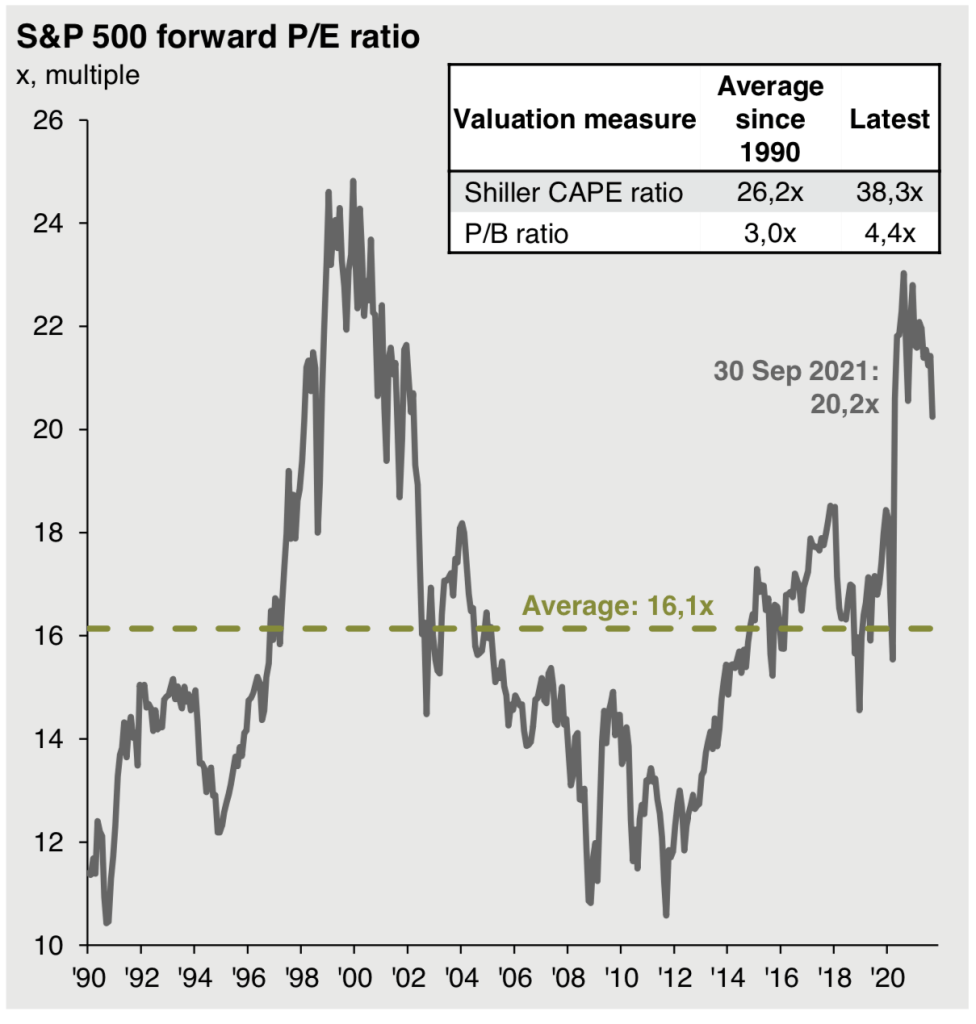
Looking at the CAPE ratio for the European market (MSCI Europe) over the past 30 years, the average has been 19.3 and is slightly higher at 20.4 (slightly higher than the 19.5 we last looked at). A nice increase compared to the level of the last 15 years. The European market is now on par with the historical average and is ‘fairly’ priced in this context.
The US market (S&P 500) has been elevated in recent years and is today significantly higher than historical levels with a CAPE of 38.3 versus an average of 26.0.
3. Tobin's Q Ratio
Developed by Nobel Laureate James Tobin, Tobin’s Q is calculated by taking a company’s market price and dividing it by the cost of replacing the company’s assets. Or to put it another way: If the ration is 1, it means that the cost of building a new company matches the market price. If the Q ratio is above 1, the company is overvalued, below 1 it is undervalued. The same can be done in whole markets, as illustrated below for the US stock market.
Current data
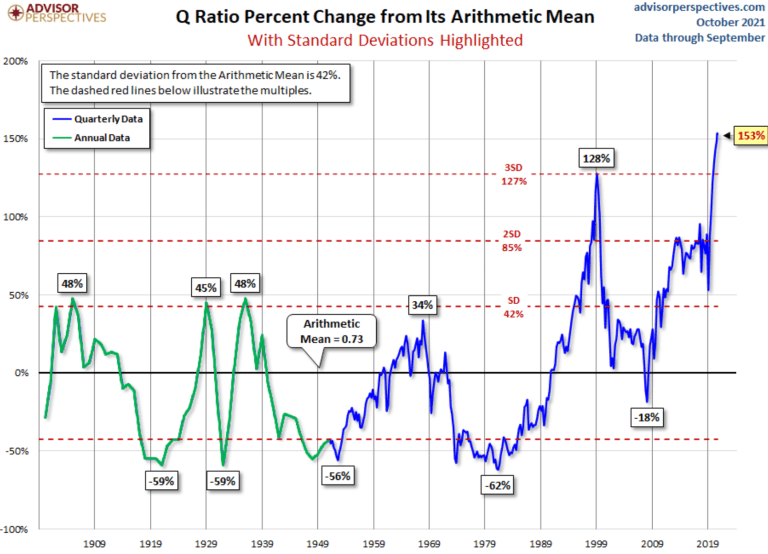
The graph above shows the development of Tobin’s Q for the US stock market (specifically the Vanguard total stock market / VTI). As you can see, we are still at the highest level in the last 100 years. Even if we only look at the last 25 years, we are at a very high level and above the level during the IT bubble in 1999.
What can we expect going forward?
If we simulate what returns we can expect based on the current market situation and the companies’ expected earnings, the future does not look particularly bright. If we look at the US market, historical figures show that the next 10 years’ returns can be expected to be in the region of 0%. Plus/minus a few percent to cover uncertainty. Thus, there has been no improvement since we looked at the figures in Q2 2021 – on the contrary, the market has continued to move to higher levels. A 0% expected return is not exactly impressive when the US market has on average returned around 8% per year.
The European market and especially emerging markets (EM), on the other hand, are quite fairly priced in a historical context. If we look at the Price/Book (P/B) ratio for MSCI Emerging Markets above, it shows an expected return in the range of 3-13% based on current price levels, with an average of 8%. This is a fairly large spread in returns, but is what is to be expected in the quite volatile emerging markets, which is also what we investors are paid.
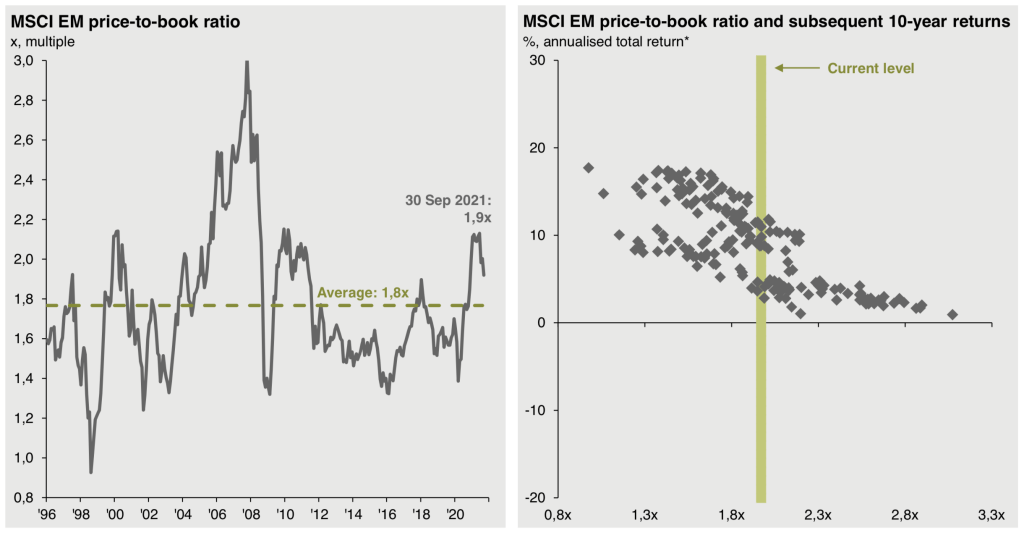
What does all this tell us about the current market?
The above three indicators all point to a market that is still at the expensive end of the scale from a historical perspective. Especially if we look at the US market.
The economic situation is fundamentally similar to what we saw in Q2 2021, and I will therefore allow myself to update what I wrote then: however, this higher historical level should also take into account that
- international interest rates are extremely low (negative in many places),
- many governments have massively stimulated economies during and after COVID-19,
- private households have continuously increased their savings and
- Many individuals have put off buying various products and services (think dinners, parties and travel) and have only started spending more money after more countries started opening up.
It’s therefore hardly surprising that despite high prices, shares still appeal to us investors. So I still don’t think we should sell and go cash. There’s really no other sensible place to put your long-term savings, and this will cause a whole host of challenges from taxes to the need to predict where the general market is headed.
That said, it seems sensible in today’s market to be a bit defensive. My specific suggestion for a long-term investor (10+ years) is to have 10% or 20% of your total savings/portfolio in cash or short-term bonds. This can be done by leaving your current savings in cash/short-term bonds, saving dividends or selling a small part of your portfolio. When the markets take one of their inevitable downward turns, you have the means to invest at more favorable prices.
If you have a larger amount of money that you want to invest, I would recommend that you
- buying into the market over a longer period of time, e.g. 20% of your savings every quarter and
- have a greater emphasis on the European or emerging markets. Both are reasonably priced in historical perspective.




